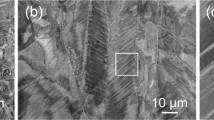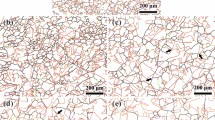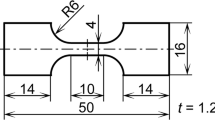Abstract
Grain boundary engineering was applied to a 316L stainless steel. The proportion of low-Σ coincidence site lattice boundaries was increased to more than 70% in the GBE specimen. The effect of grain boundary character distribution formed through GBE on the mechanical properties at different strain rates (4 × 10−2, 4 × 10−3, 4 × 10−4, 4 × 10−5 s−1) was studied by tensile test at room temperature. The results showed that the GBE specimens exhibited higher uniform elongation than the non-GBE specimens. With the strain rate decreasing, the uniform elongations of GBE specimens had a greater extent of increase. The local misorientation, average Schmid factor (\( \overline{m} \)) and Taylor factor (M) in GBE and non-GBE specimens at uniform plastic deformation area were studied by using electron backscatter diffraction. The results indicate that the micro-zone strain was more uniformly distributed and the activation process of the slip system was apt to happen in the GBE specimens.















Similar content being viewed by others
References
Ikeda S (2010) Technical progress of stainless steel and its future trend. Nippon Steel Tech Rep 99:2–8
Kumar BR, Chowdhury SG, Narasaiah N, Mahato B, Das SK (2007) Role of grain boundary character distribution on tensile properties of 304L stainless steel. Metall Mater Trans A 38(5):1136–1143
Sakaguchi N, Watanabe S, Takahashi H (2005) A new model for radiation-induced grain boundary segregation with grain boundary movement in concentrated alloy system. J Mater Sci 40(4):889–893. doi:10.1007/s10853-005-6506-3
Tsurekawa S, Okamoto K, Kawahara K, Watanabe T (2005) The control of grain boundary segregation and segregation-induced brittleness in iron by the application of a magnetic field. J Mater Sci 40(4):895–901. doi:10.1007/s10853-005-6507-2
Raabe D, Herbig M, Sandlöbes S, Li Y, Tytko D (2014) Grain boundary segregation engineering in metallic alloys: a pathway to the design of interfaces. Curr Opin Solid State Mater Sci 18(4):253–261
Alexandreanu B, Was GS (2006) The role of stress in the efficacy of coincident site lattice boundaries in improving creep and stress corrosion cracking. Scr Mater 54(6):1047–1052
Boehlert CJ (2008) The effect of thermomechanical processing on the creep behavior of Alloy 690. Mater Sci Eng A 473(1–2):233–237
Hu CL, Xia S, Li H, Liu TG, Zhou BX, Chen WJ (2011) Improving the intergranular corrosion resistance of 304 stainless steel by grain boundary network control. Corros Sci 53(5):1880–1886
Palumbo G, Erb U (1999) Enhancing the operating life and performance of lead-acid batteries via grain-boundary engineering. MRS Bull 24(11):27–32
Michiuchi M, Kokawa H, Wang ZJ, Sato YS, Sakai K (2006) Twin-induced grain boundary engineering for 316 austenitic stainless steel. Acta Mater 54(19):5179–5184
Xia S, Li H, Liu TG, Zhou BX (2011) Appling grain boundary engineering to Alloy 690 tube for enhancing intergranular corrosion resistance. J Nucl Mater 416(3):303–310
Zhang ZW, Wang WH, Zou Y, Baker I, Chen D, Liang YF (2015) Control of grain boundary character distribution and its effects on the deformation of Fe–6.5 wt% Si. J Alloys Compd 639:40–44
Watanable T (1984) Approach to grain boundary design for strong and ductile polycrystals. Res Mech 11:47–84
Kumar M, Schwartz AJ, King WE (2002) Microstructural evolution during grain boundary engineering of low to medium stacking fault energy fcc materials. Acta Mater 50(10):2599–2612
Watanabe T (2011) Grain boundary engineering: historical perspective and future prospects. J Mater Sci 46(12):4095–4115. doi:10.1007/s10853-011-5393-z
Randle V, Coleman M (2009) A study of low-strain and medium-strain grain boundary engineering. Acta Mater 57(11):3410–3421
Li B, Tin S (2014) The role of deformation temperature and strain on grain boundary engineering of Inconel 600. Mater Sci Eng A 603(5):104–113
Randle V, Hu Y (2009) The role of vicinal Σ3 boundaries and Σ9 boundaries in grain boundary engineering. J Mater Sci 40(12):3243–3246. doi:10.1007/s10853-005-2692-2
Liu TG, Xia S, Li H, Zhou BX, Bai Q (2014) Effect of the pre-existing carbides on the grain boundary network during grain boundary engineering in a nickel based alloy. Mater Charact 91:89–100
Engelberg DL, Newman RC, Marrow TJ (2008) Effect of thermomechanical process history on grain boundary control in an austenitic stainless steel. Scr Mater 59(5):554–557
Richard J, Randle V (2010) Sensitisation behaviour of grain boundary engineered austenitic stainless steel. Mater Sci Eng A 527(16–17):4275–4280
Lee SL, Richardsr NL (2005) The effect of single-step low strain and annealing of nickel on grain boundary character. Mater Sci Eng A 390(1–2):81–87
Rohrer GS, Randle V, Kim CS, Hu Y (2006) Changes in the five-parameter grain boundary character distribution in α-brass brought about by iterative thermomechanical processing. Acta Mater 54(17):4489–4502
Kobayashi S, Nakamura M, Tsurekawa S, Watanabe T (2011) Effect of grain boundary microstructure on fatigue crack propagation in austenitic stainless steel. J Mater Sci 46(12):4254–4260. doi:10.1007/s10853-010-5238-1
Sinha S, Kim DI, Fleury E, Suwas S (2015) Effect of grain boundary engineering on the microstructure and mechanical properties of copper containing austenitic stainless steel. Mater Sci Eng A 626:175–185
Hansen N (2004) Hall–Petch relation and boundary strengthening. Scr Mater 51(8):801–806
Schino AD, Barteri M, Kenny JM (2003) Effects of grain size on the properties of a low nickel austenitic stainless steel. J Mater Sci 38(23):4725–4733. doi:10.1023/A:1027470917858
Wang ZG, Zhang ZF, Li XW, Jia WP, Li SX (2001) Orientation dependence of the cyclic deformation behavior and the role of grain boundaries in fatigue damage in copper crystals. Mater Sci Eng A 321(12):63–73
Detrois M, Rotella J, Goetz RL, Helmink RC, Tin S (2016) Grain boundary engineering of powder processed Ni-base superalloy RR1000: influence of the deformation parameters. Mater Sci Eng A 627:95–105
Palumbo G, Aust KT, Lehockey EM, Erb U, Lin P (1998) On a more restrictive geometric criterion for “special” CSL grain boundaries. Scr Mater 38(11):1685–1690
Lichtenfeld JA, Mataya MC, Tyne CJV (2006) Effect of strain rate on stress-strain behavior of alloy 309 and 304L austenitic stainless steel. Metall Mater Trans A 37(1):147–161
Campbell JD, Ferguson WG (1970) The temperature and strain-rate dependence of the shear strength of mild steel. Philos Mag 21(169):63–82
Liu YN, Zhu JH (1990) Strength of a low carbon steel at different temperatures and strain rates. Chin J Mater Res 4(4):285–290
Atwell DL, Barnett MR, Hutchinson WB (2012) The effect of initial grain size and temperature on the tensile properties of magnesium alloy AZ31 sheet. Mater Sci Eng A 549(7):1–6
Sinha S, Szpunar JA, Kumar NAPK, Gurao NP (2015) Tensile deformation of 316L austenitic stainless steel using in situ electron backscatter diffraction and crystal plasticity simulations. Mater Sci Eng A 637:48–55
Chakrabarty S, Mishra SK, Pant P (2014) Crystallographic orientation and boundary effects on misorientation development in austenitic stainless steel. Mater Sci Eng A 617:228–234
Lu K, Lu L, Suresh S (2009) Strengthening materials by engineering coherent internal boundaries at the nanoscale. Science 324(5925):349–352
Meyers MA, Mishra A, Benson DJ (2006) Mechanical properties of nanocrystalline materials. Prog Mater Sci 51(4):427–556
Lehockey EM, Palumbo G, Lin P (1998) Grain boundary structure effects on cold work embrittlement of microalloyed steels. Scr Mater 39(39):353–358
Lee TC, Robertson IM, Birnbaum HK (1990) TEM in situ deformation study of the interaction of lattice dislocations with grain boundaries in metals. Philos Mag A 62(1):131–153
Cui HW (2013) Plastical deformation and microstructural formation of icosahedral quasicrystalline reinforced Mg–Zn–Y alloys. PhD Dissertation, Shandong University
Fukuya K, Nishioka H, Fujii K (2011) An EBSD examination of SUS316 stainless steel irradiated to 73 dpa and deformed at 593 K. J Nucl Mater 417(1–3):958–962
Gärtner F, Stoltenhoff T, Voyer J (2006) Mechanical properties of cold-sprayed and thermally sprayed copper coatings. Surf Coat Technol 200(24):6770–6782
Acknowledgements
This work was supported by the National Natural Science Foundation of China (NSFC) (Grant Number 51671122).
Author information
Authors and Affiliations
Corresponding author
Rights and permissions
About this article
Cite this article
Zhuo, Z., Xia, S., Bai, Q. et al. The effect of grain boundary character distribution on the mechanical properties at different strain rates of a 316L stainless steel. J Mater Sci 53, 2844–2858 (2018). https://doi.org/10.1007/s10853-017-1695-0
Received:
Accepted:
Published:
Issue Date:
DOI: https://doi.org/10.1007/s10853-017-1695-0




